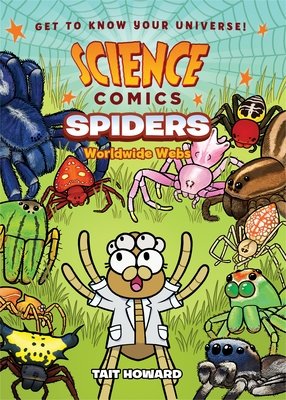An-Animal-a-Month: Spiders
Photo credit: Vasiliy Vishnevskiy, Dreamstime.com
Fear not! 99.9% of spiders are not harmful to humans. Share these exemplary titles with students to help dispel fears and build knowledge about these amazing creatures.
Facts help dispel fears! Whether your students and children fear or love spiders, this stunning title by Annette Whipple will help kids appreciate the staggering diversity, mind-blowing adaptations, and important roles of spiders. The main text answers eleven fundamental questions about spiders, from what makes a spider a spider to how they hunt and how they grow up. Close-up photographs with captions, embedded within strikingly laid-out spreads, support the main text, while illustrated sidebars add humor and more facts. The voice is inspiring, conversational, and encouraging. Six pages of back matter extend the learning and include a STEAM craft project. Ages 6-9.
Kind of nonfiction: To me, this title falls between traditional nonfiction and expository literature. Although it broadly covers spiders like a traditional nonfiction book, the voice, layout, photos, and humorous sidebars read like expository literature. (My categorization using Melissa Stewart’s 5 Kinds of Nonfiction.)
Ties to Next Generation Science Standards:
K-ESS2-2 (Construct an argument supported by evidence for how plants and animals (including humans) can change the environment to meet their needs.) Pages 10-11 show how spiders change the environment by building webs to catch food. Four different kinds of webs are shown. Page 7 shows how the diving bell spider brings air into an underwater nest and how a trap-door spider creates a silk door to hide under.
3-LS1-1 (Develop models to describe that organisms have unique and diverse life cycles but all have in common birth, growth, reproduction, and death.) On pages 22-25, students will find information on diverse spider life cycles, from spiders who die after laying eggs to spiders who care for their young. Eggs, molting, and growth are also discussed. Students can compare the spider life cycle to the more familiar cycles of butterflies and amphibians.
4-LS1-1 (Construct an argument that plants and animals have internal and external structures that function to support survival, growth, behavior, and reproduction.) Pages 8-9 show the spinneret structure, from which spiders pull silk building webs, shelters, and egg cases. Page 15 details how a spider’s venom-filled fangs allow them to paralyze and liquefy their prey, thus allowing them to eat without chewing. Pages 18-19 detail how the hairs that cover spiders’ bodies allow spiders to feel vibrations (unsaid - vibrations of prey caught in their webs) or locate flying prey or act as a defense against predators. Hairs on their feet also give them traction for walking and climbing. Page 21 shows how a male peacock spider’s fan helps him find a mate.
Hunting in microgravity! Can a spider learn how to leap and catch fruit flies in the low-gravity environment of the International Space Station? This was the question posed by a student and answered by a jumping spider, a biologist, and an astronaut. The true story of follows Nefertiti as she travels the globe, rockets to the ISS, re-learns how to hunt, and then returns to Earth. Your students and children will meet a woman biologist and a woman astronaut, who together plan and execute the experiment. Children may also come to appreciate and admire little Nefertiti as she struggles to overcome the challenges of aiming her predatory jumps in space and then back on Earth. Back matter provides more details about Nefertiti, vocabulary related to the story, plus how and why the experiment happened in the first place. An inspiring, eloquently-written story about both space research and the amazing learning capacity of a tiny creature. Ages 6-10. (Please note this title is a bit older than many books that I showcase. It was published in 2016, but I found it at the library and think it’s still timely and important.)
Kind of nonfiction: Narrative. Using real characters, a story arc, and emotional resonance, this book immerses the reader in the experience of Nefertiti and the people who worked with her. (My categorization using Melissa Stewart’s 5 Kinds of Nonfiction.)
Packed with humour, adventure, and astounding facts! When a spider-fearing brother and spider-loving sister are sent to fetch glassware from the basement, a spider uses a shrink gun to reduce the children to her size. The spider offers to teach the children all about spiders in exchange for their help. Together they set off on an adventure to find the spider’s missing child. Along the way, they come across and learn about myriad species of spiders and their amazing spider ways. Copious, unusual facts fill the pages, including how spiders can produce up to eight different kinds of silk, how transgenic goats have produced spider-silk protein in their milk, exactly how spiders make webs, how ballooning relies on electrical energy from Earth, and what to do if you are bitten. Find a glossary at the end. A fun and informative read for middle schoolers, ages 9-13.
Kind of book: A graphic novel or comic. It’s a mix of a fictional narrative story and nonfiction expository spider facts. (My categorization using Melissa Stewart’s 5 Kinds of Nonfiction.)



